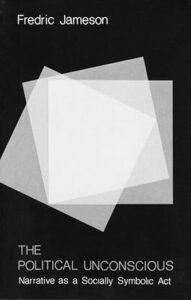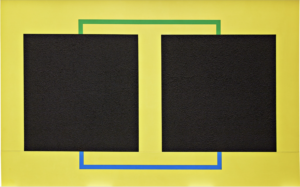For the thousand manifestations that dotted the American landscape yesterday, I want to post this broadside poem by Robert Creeley. It has always seemed a kind lurching effusion of a politics, a consequence of the state of mind he wrote it in without doubt. Creeley was often convulsive, and that is to the point of his aesthetic, even concerning details. But here the subject of his “attack” in William Carlos Williams’s sense is broad, vast, gestural, involuntary. It is worth remembering that much poetry that followed shelters in the shadow of that attack. Thus it bears some comment at a later moment, as late as the one we are in, where the poem resonates anew. … More
>> Documents <<
March 1, 2025
Event 104: Signifying Non-Solutions
“Dispersed Poetics: Signifying Non-Solutions
in Time of War”
Ekaterina Derisheva, University of Pennsylvania
Barrett Watten, Wayne State University
Jamie Olson, St. Martin’s University
The Louisville Conference on Literature and Culture
University of Louisville, February 22, 2025
“Dispersed Poetics: Signifying Non-Solutions in Time of War” introduces the work of experimental poets writing in Russian and Ukrainian, from positions of opposition, emigration, and displacement, from the late Soviet period to the present conditions of war and exile. The notion that “the non-solution must signify” is a formulation by critic Terry Eagleton that seems apt to the present moment, where poetry can best address a situation of profound indeterminacy.
December 1, 2024
Entry 64: Communicating Vessels II
Marxism, at the end of the 19th century and the beginning of the 20th century, admitted that in capitalist societies mankind had not reached its full possibilities for development and self-realization. . . . [What] model did Marxism use to conceive, project, and eventually realize that human nature? It was, in fact, the bourgeois model: sexuality of a bourgeois type, family of bourgeois type, aesthetic of bourgeois type. —Michel Foucault, “Human Nature: The Chomsky-Foucault Debate” (1971)
I am in a medical waiting room in Novi, Michigan, reading the politics of dream in Les Vases communicants. On a large screen unfold tedious details of home improvement projects, finding new spatial arrangements, knocking out windows, sanding floors. Three older women are facing the screen, representative of Novi and its majority suburban demographics. They are possibly X voters, I imagine. Interrupting the quotidian program are three election ads, two paid for by Y and one by X. The space of the waiting room becomes a scene of unfolding dreams. In the first, X brags that he only hires the best in the business. We next meet a series of former subordinates, from A to B. All are white male counter authorities, having once believed in but turned from X. The message is impactful and distressing, a diremption in the structure of legitimacy. It provokes displeasure and crisis that cannot be revealed among the three women, who rigidly stare straight ahead. The next features a sympathetic woman they might identify with: an older white woman in an ordinary scene. Social security will be at risk under X, she explains. She finishes her argument with a risqué turn of speech: he will give the middle finger to the middle class. The three women’s basic livelihood appears at risk, after the legitimacy crisis. The third ad feature a younger women who claims the federal government, under Y, will pay for gender reassignment care. She is a mother and there is an imagined threat to her obligation to care for her child in the way she believes. The first two messages attack certainty in order to draw out and question a core belief. The last preserves a core belief by promoting an untenable fantasy. At the bottom of the dream is a nonexistent object that the three messages attempt to disclose. How much of the disclosure itself—seeing the ad content as analogous to a dream on waking—can be retained on waking; what does the erosion of memory mean for the core belief? In two cases the core belief is unsettled; in the latter, it is preserved as inaccessible fantasy, what people may think but will not admit to, the basis for a turn to fascism in a democracy. My reading of Les Vases communicants extends, of necessity, from 1932 to this scene.
“The Best People,” Harris campaign ad: view here
“Kamala Is for They/Them. I am for you” ad: view here
November 23, 2024
Document 106: Various Devices!
VARIOUS DEVICES:
SELECTED WRITINGS
BY CARLA HARRYMAN
MOSCOW: POLYPHEM, 2024
[for Russian text, click here]
Polyphem, an independent press in Moscow, announces publication of a comprehensive, bilingual edition of the writings of Carla Harryman.
The works, chosen by editor Vladimir Feshchenko, represent the full range of her pioneering genre-disrupting, performative texts—from Percentage (1979) and Under the Bridge (1980) to Cloud Cantata (2020) and Scales for the Living (2023).
Also featured are the complete scripts of her germinal works for San Francisco Poets Theater: “Third Man” (1978); “There Is Nothing Better Than a Theory” (1984); and “Memory Play” (1994).
Excerpts from her dystopian novel Gardener of Stars (2001) and the ludic hybrid text Baby (2005) are included, along with selections from her erotic picaresque, co-authored with Lyn Hejinian, The Wide Road (2011). … More
November 22, 2024
Document 105: Not This!
NOT THIS: SELECTED WRITINGS
BY BARRETT WATTEN
MOSCOW: POLYPHEM, 2024
[for Russian text, click here]
Polyphem, an independent press in Moscow, has announced publication of a comprehensive, bilingual edition of the writings of Barrett Watten.
The works, chosen by editor Vladimir Feshchenko, extend from his first collection (Opera—Works, 1975) to the unpublished “Notzeit,” written during COVID (2020).
The selection represents the author’s “turn to language” in the 1970s, his development of hybrid genres and longer forms, and his critique of distorted social communication. … More
October 4, 2024
Entry 62: The One Great Story
Remarks on Jameson and Narrative
Under any house is a basement of psychological dimensions, a surplus affective space. And as I read The Political Unconscious into the night, a sump pump in the basement would go on and off, shunting gallons of water out of its perpetual flood. An editor asked me for a theory of such drainage in the form of a critical review, which I refused as not entirely serious. —”Foxes,” Bad History, 60
 The year is 1981. Carla Harryman and I are living in a working-class bungalow on Hampshire Street in San Francisco’s Mission District, competing with raccoon families and occasional gunshots to establish a relationship in an indeterminate time. Ronald Reagan has been elected, while the alternative arts are forging ahead on multiple agendas. Poets Theater is in full swing, with a character called “Jameson” in Kit Robinson’s play, as I discussed previously. Jameson has entered the Language and New Narrative debates and given his talk at 80 Langton Street, siding with Narrative while symptomatizing Language, but also has now published The Political Unconscious, a watershed work that would have long-term impact on questions of narrative and form. Jameson’s “questions of interpretation,” bringing together form and history, would anchor a more expansive, contextual methodology not confined to surface language—bypassing precisely the critique of Language’s dissociation of sensibility in the postmodern. The “turn to history” via poetic form begins right here. … More
The year is 1981. Carla Harryman and I are living in a working-class bungalow on Hampshire Street in San Francisco’s Mission District, competing with raccoon families and occasional gunshots to establish a relationship in an indeterminate time. Ronald Reagan has been elected, while the alternative arts are forging ahead on multiple agendas. Poets Theater is in full swing, with a character called “Jameson” in Kit Robinson’s play, as I discussed previously. Jameson has entered the Language and New Narrative debates and given his talk at 80 Langton Street, siding with Narrative while symptomatizing Language, but also has now published The Political Unconscious, a watershed work that would have long-term impact on questions of narrative and form. Jameson’s “questions of interpretation,” bringing together form and history, would anchor a more expansive, contextual methodology not confined to surface language—bypassing precisely the critique of Language’s dissociation of sensibility in the postmodern. The “turn to history” via poetic form begins right here. … More
September 29, 2024
Entry 61: History Is What Hurts
Remarks on Jameson and Language
 The media, for once, are getting it right: with the announcement of Fredric Jameson’s passing on September 22, one often sees a likeable photo of an engaged, outer-directed, smiling and welcoming, if prodigious and awe-inspiring scholar and critic in early or late days of his notable life and career. There is something of the Peaceable Kingdom in the intellectual devotion and worldly accomplishments evoked: “For Fredric Jameson, Marxist Criticism Was a Labor of Love,” per The New York Times. While Critical Theory, in both nature and practice, accentuates the negative, Late Jameson presents a beneficent gaze that is rarely encountered—especially with Marxists. The Grand Narrative of Progress Toward a Better Life seems activated by his very presence, a moment of positivity restored at the moment of loss. … More
The media, for once, are getting it right: with the announcement of Fredric Jameson’s passing on September 22, one often sees a likeable photo of an engaged, outer-directed, smiling and welcoming, if prodigious and awe-inspiring scholar and critic in early or late days of his notable life and career. There is something of the Peaceable Kingdom in the intellectual devotion and worldly accomplishments evoked: “For Fredric Jameson, Marxist Criticism Was a Labor of Love,” per The New York Times. While Critical Theory, in both nature and practice, accentuates the negative, Late Jameson presents a beneficent gaze that is rarely encountered—especially with Marxists. The Grand Narrative of Progress Toward a Better Life seems activated by his very presence, a moment of positivity restored at the moment of loss. … More
August 11, 2024
Entry 60: The Indexical Present II
The photo registers the scene: it is Ron Silliman reading, Krishna Evans following the text. Or perhaps Krishna is reading and Ron is following the text, as will be the case in a minute or two, as soon as Ron finishes his passage. The vantage point is from where I am sitting, having read my part some time ago and now listening as it continues. To the side are Eliot D’Silva next to Ivan Sokolov; then to the right are Jen Hofer, leaning against the garage; Claire Marie Stancek is just behind the forked trunk of a tree; Jennifer Scappettone between the branches of the tree, and Jane Gregory, the host of the event, is to the far right. Continuing out of the picture one would encounter Lytle Shaw, whose elbow is just visible, and then next Syd Staiti on the stairs. Everyone is not especially solemn but bent to the task, reading Lyn Hejinian’s just published Fall Creek (Litmus Press), copies and xeroxes of which are out on the table. All of them have taken their turn. There are thirty-three sections, with Ron and Krishna reading the next-to-final two, before the group takes up the last section in unison. This was my proposal to the group at the break, recalling the pleasure of cacophony in our Grand Piano reading of “A”–24, whose plurivocality Lyn internalized and, some decades later, realized in one of her last works. … More
February 11, 2024
Document 102: Note on Conduit
“Conduit” (“Kanal svyazi”)
trans. Arkadii Dragomoshchenko and Vladimir Feshchenko
Vsealizm (Moscow), 11 February 2024
From Moscow, for the second week in a row, comes a new translation of my work into Russian—here, “Conduit” into “Kanal svyazi”—in preparation for a bilingual edition to appear, one hopes, later this year. This work, brought forward over decades and across continents, truly stands as a conduit in the distressed conditions of communication, between the “territories of the East” and the rest of the world assuredly, but more generally as “what we live.” As I wrote on receiving word of this wonder:
There was a line from a Poets Theater play, Third Man by Carla Harryman, early 80s, spoken by Eileen Corder: “Go ahead, Moscow—I’m listening!” That was transgressive in the Reagan Era; in the current moment, one listens carefully to say the least. And now this translation of my poem “Conduit” has appeared—it is all about receiving messages, and not letting them stand as commonplaces or placeholders but as samples of “systematic distortion.” It’s about the “systematic distortion” of communication as communication itself, which we experience every day.




















